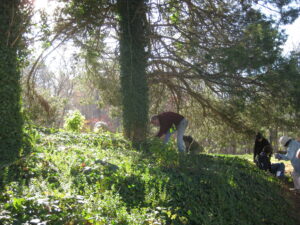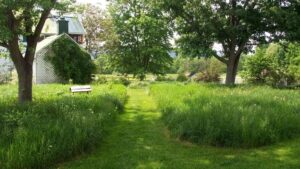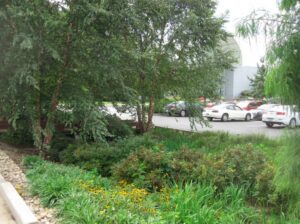The following article was published in the Transylvania Times. However, if you don’t have a subscription to this great news paper and are stymied by their paywall, you are in luck. The author is Equinox’s very own Senior Plant Ecologist, Owen Carson, and he has shared it with us. You can find the published article here: https://www.transylvaniatimes.com/outdoors/make-ecosystems-matter-again/article_b5e898d8-bbb2-11ee-abe9-036b6dcef75b.html
I don’t know about you, but often when I sit down and think about the pressures facing our environment, I quickly start to feel overwhelmed. Natural landscapes are shrinking, being replaced by sprawling hardscapes, roads are growing longer and wider, farmlands are being converted into fancy second home developments, wildlife habitats have been decimated. The advances in environmental protections that we began making in the 70s have seemingly plateaued, and an ever-growing human population that needs spaces to live, work, and play is ramping up pressures on natural systems that have become so fragmented that we are in jeopardy of losing them, and their constituent elements, outright.
The story is not all doom and gloom, however. There is hope, and it lies within each and every one of us. Together we can become better stewards of the land, and we can do it by taking control of things within our own spaces, so instead of dooming our ecosystems to a “death by a thousand cuts”, we can reinvigorate their health and bring them “life by a thousand bandages”. I’d like to share some simple ways that we can take fate into our own hands, promote beauty and biodiversity, and place an intentional focus on improving the ecosystems that we rely on.
To some, the traditional lawn is as American as apple pie, something to show off, take pride in. And while lawns do provide good recreational spaces for families and kids, they do almost nothing to support the native ecosystems within which they’re placed. They are monocultures, black holes of biodiversity, and offer little in terms of forage or habitat for wildlife. Furthermore, lawns are resource hogs – they require regular watering, fertilizer and pesticides, and are often managed with tools that burn fossil fuels and emit greenhouse gases, each of which comes with a fiscal and environmental cost. What’s the point?
I say, ‘kill your lawn’, or at least shrink it down, and replace it with plants that provide form, function, aesthetic, and habitat; create a “yarden”. And trust me, this doesn’t have to happen in one fell swoop – start small, stop mowing, see what plants begin to emerge from the seed bank. Chances are you’ll be surprised at what pops up. Download the iNaturalist app and use it to identify and track what emerges to understand what’s native and what’s not, and then make decisions on how to manage undesirable species. Employ the philosophy of increasing biodiversity through “Addition and attrition” – plant things you want, and make space for other native plants to come in. In my yarden, I have chosen to “roughen the edges”, allowing the perimeter of the lawn to become wild, and have created “islands” of native plant groupings interspersed within. Each year I allow the edges to grow in a bit more but continue to manage some areas with traditional lawn such that the lawn becomes a neat, clean pathway amidst wild native meadows and gardens; this juxtaposition balances our needs and also creates landscape interest.
For those landowners who have property along a creek or river, one of the best things you can do is to allow for the establishment of a healthy, vegetated riparian buffer with a diverse mix of plants. In contrast, habits such as mowing all the way to the edge of the bank, removing vegetation so you can see the creek, and maintaining a monoculture of grass, all of those lead ultimately to a decrease in water quality and the potential for bank instability and failure. Not only does riparian vegetation play a stabilizing role by creating a strong network of roots that hold soil and resist flood flows, but it also helps to filter out stormwater that is flowing across the floodplain, catching sediment and other pollutants, slowing the flow of stormwater, and allowing it to cool down before reentering the system. Furthermore, many of the native species that typically occupy riparian zones are beautiful and interesting, producing flowers and fruit, and having colorful or architectural interest in the winter. Finally, a healthy and diverse buffer offers excellent habitat heterogeneity for aquatic and terrestrial native wildlife; shaded creeks stay cooler and thus are more suitable for coldwater aquatic species and provide important nutrient inputs as they drop organic debris into the system, feeding aquatic insects that in turn feed larger predators up the food chain. Likewise, birds, mammals, reptiles, and amphibians all thrive in the various levels of a healthy riparian forest.
Manage Nonnative Invasive Plants (NNIP) 
Many traditional residential landscapes reflect a modus operandi of control over an artificial system, rather than function within a natural one. We like certain plants for certain reasons and have the choice to put them where we want, but after centuries of doing so without consideration of the nativity of our selections and the native ecosystems within which we’re planting, the negative ecological ramifications of our behavior are nothing short of eye-opening. Not only have imported utilitarian plants like multiflora rose, kudzu, Chinese privet, and autumn olive invaded large swaths of our natural and transitional landscapes since their introduction decades ago, but landowners are still actively planting other highly invasive ornamentals such as Japanese barberry, butterfly bush, Chinese silvergrass, Japanese spiraea, nandina, burning bush, and English ivy. I think people are generally unaware of how far these plants can spread from where they are established, and I often hear folks rebut that “well it hasn’t invaded on my property”, yet a short walk through the neighborhood would likely cause them to reevaluate their assertion…those plants get around! In fact, one of the most prevalent landscape plants that I have found escaped into natural areas in the county is butterfly bush, a plant that is sold daily at big box stores and local nurseries.
Like shrinking the lawn, taking a methodical, systematic approach is the best way to gain control of NNIP in your landscape, even if you have a lot of them. First rule: do no harm, e.g. don’t plant nonnative invasive plants! Select native species instead, or at least those that are not invasive. Next, actively manage populations of NNIP, prioritizing control of species that spread the quickest. Even if you can’t remove a plant outright for whatever reason, simply removing its reproductive parts (flowers, fruits) will prevent their seeds from spreading outside of your property.
Use Integrated Pest Management techniques: arm yourself with a wide array of tools, which could range from chainsaws and shovels (manual control), to goats and introduced fire (cultural control), to targeted applications of herbicides (chemical control); its most important to remember that no one way is the best, and that integration of multiple techniques over time yields the best results. Refer to Miller’s “A Management Guide for Invasive Plants in Southern Forests”, a free publication provided by the US Forest Service, to assist in your efforts.
Following years of introduction of all sorts of nonnative plants into our landscapes and the resulting ecological disruptions, it’s time to get back to our native roots and begin intentionally selecting for a mostly native landscape. Not only are native plants perfectly adapted to local climates through the process of natural selection occurring over millennia, they are also vitally important to the ecological relationships they have formed with native fauna over the same time period. Conversely, planting nonnative plants that aren’t well suited for local conditions leads to perennial management woes. So I often ask folks: why plant something alien that needs constant input when you could select a native species that needs almost nothing to survive and thrive? The answer is always different, and usually lies somewhere between nostalgia (“my grandma loved that bush and I can’t bear to cut it down”); preference (“I really just love the fall color of burning bush”), convenience (“Lowe’s always has it in stock”) , and stubbornness (“why should I change the way I do things, it’s my land”).
Fortunately, rebuttals to those arguments are now simple, and there are enough folks out there trying to turn the tide that it becomes increasingly difficult to justify not planting native species. Planting guides have been created to guide homeowners towards selecting native plants that have the same landscape interest as traditional nonnatives. Local nurseries featuring exclusively native plants are increasingly popping up. Incentives are coming available to homeowners through county agencies to replace commonly planted nonnatives, like Bradford pear, with beneficial native species, such as serviceberry, hog plum, black cherry, and others. Furthermore, when creating entirely new landscapes, landowners have the opportunity to reflect elements of the historic native ecosystems that once occupied their land; exploring reference habitats can help designers develop a diverse and ecologically appropriate palette of plants for the landscape. They can even use native plants to enhance aspects of the landscape that are typically seen as constraints, such as low-lying/wet spots, or areas with shallow or poor soils; targeting these areas with specifically adapted native plants will add interest and provide niche habitats for indigenous flora and fauna.
As the pace of development continues to grow and natural land is converted, so shrinks the available space for native fauna. Wildlife utilize the landscape for refuge, forage, and reproduction, and require a fair amount of heterogeneity for their populations to sufficiently thrive. While we have no control over those spaces, we can utilize our own properties to create, promote, and diversify wildlife habitat in order to offset the continued fragmentation. From a cultural perspective, we can make small changes to our landscape management habits that will have a significant positive effect; actions like leaving flowering stalks standing through the winter, and allowing fallen leaves to biodegrade where they land, are easy to do and allow for native insects, such as mason and leafcutter bees and wooly worms (which become Isabella tiger moths), to complete key portions of their life cycles, ensuring subsequent generations. Other simple actions include creating small brush piles within open areas, which provides cover for birds and small mammals and forage for reptiles, erecting refugia for declining species such as bluebirds and martins, and even constructing small “bee hotels”.
Also, in certain cases the omission or alteration of landscaping features, such as lighting, can affect the presence or absence of niche wildlife, like bats; simple things like facing lights downwards or reducing the brilliance can dramatically influence bat behavior and presence. Intentional actions like these, however small, can make a big difference in increasing habitat availability and diversity for wildlife. Finally, remember that native wildlife, such as raccoons, coyotes, skunks, and bears, have learned to exploit various human-caused scenarios, such as trash cans, compost piles, outdoor pets, and livestock (e.g. chickens); try to consider this before assigning a label of “good” or “bad” to any given critter, and recognize that human behavior is intrinsically linked to that of wildlife!
Stormwater management is a hot topic in the mountains. Improperly managed stormwater leads to flooding in houses, streets, streams, and rivers, and negatively affects water quality and chemistry, which stresses aquatic organisms and systems. Stormwater is often noticed by folks when it turns rivers brown, makes roads impassable, or leads to landslides, but people often forget that it starts, in part, on their rooftops and in their gutters and downspouts. The traditional way to treat it is to get it away as soon as possible – gutter to downspout to French drain to curb (or straight to the creek) – but to apply the “good, fast, cheap” adage, getting the water away quickly and at a low-cost leads to bad consequences in the form of high velocity, warm temperature, pollutant-laden stormwater. We need to reimagine the way we manage stormwater, and the easiest way to do this is to disconnect the line, starting at the end of the downspout, and letting your landscape perform the treatment. Through the use of bioswales and vegetated retention ponds, we can capture, slow down, cool off, and clean stormwater before it reenters the nearest creek or storm drain. When waterbodies are buffered from dramatic fluctuations in velocity and temperature, they are more stable and less likely to degrade. Furthermore, keeping stormwater onsite also allows for increased infiltration, which helps keep our aquifers full, which increases landscape resiliency during times of drought.
The Takeaway
I’ve said a lot, offered up many suggestions for folks to improve their relationship with nature at the landscape level. Not all of it applies to every landscape, and there are certainly spaces where none of these suggestions would work. However, if you were to take away only one point from this discussion, I hope it would be that you matter, your actions matter, and you each have the capacity to effect positive ecological change simply by rethinking the way you engage with your landscape. Baby steps, small, incremental changes, humility. We humans are not separate from the ecosystem, we are part of it, and our unique traits of intelligence and ingenuity should inspire us to take responsibility, to be stewards, to think outside of ourselves, and to respect the power of nature.





